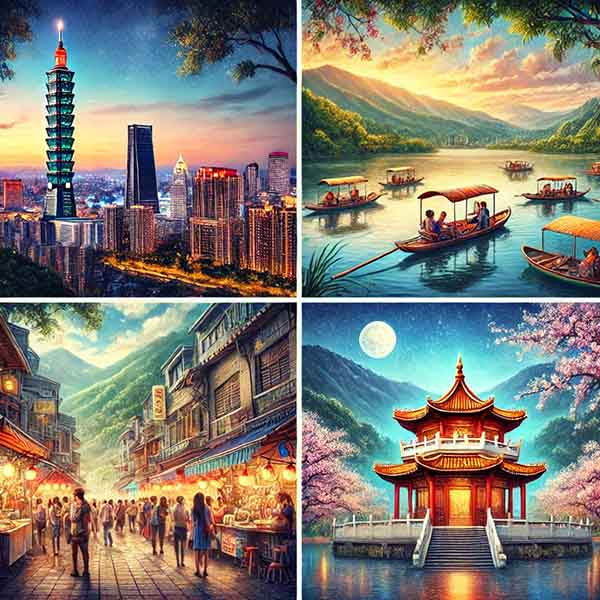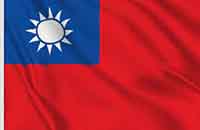Taiwan Statistics
Demographics of Taiwan
When thinking about Taiwan, many may immediately picture its busy capital of Taipei, but there’s so much more to this country. Taiwan’s unique blend of modern infrastructure and natural beauty makes it a fascinating place to visit, reside and also to study from a statistical perspective. The island, though small compared to many of its neighbors, packs an impressive array of geographical and cultural variety into its 13,976 square miles. With a population of over 23 million people, Taiwan is one of the most densely populated countries in the world. Much of this population is concentrated in urban areas along the west coast. Despite its size, Taiwan ranks high in economic power and technological innovation. It consistently is placed among the world’s top economies in sectors like electronics and semiconductors.

Taiwan Holds Many Geographical Secrets
One of Taiwan’s most striking characteristics is its geographical complexity. About 70% of the island is covered by mountains, with towering peaks like Yushan (Jade Mountain) offering a dramatic contrast to the flat plains and rolling hills in the west. Taiwan also experiences a variety of climates due to its geographical position, ranging from tropical in the south to subtropical in the north. This variation in elevation and climate has created a wide spectrum ecosystem. Taiwan is home to a wide array of wildlife and plant species, many of which are endemic to the island. It’s no surprise Taiwan is also a major destination for eco-tourism, with visitors flocking to its national parks and scenic areas to witness the beauty of its landscapes and the biodiversity.
Economically, Taiwan is the 22nd largest economy in the world, driven by its highly developed technology and manufacturing industries. Taiwan is the global leader in semiconductor production. Here in this small land mass country we provide key components powering everything from smartphones to computers and cars. Taiwan also boasts a well-educated workforce, with one of the highest literacy rates in the world, standing at 98.5%. The country places great importance on education and innovation, which are key drivers of its competitive edge on the global stage.
From an environmental standpoint, Taiwan has made significant strides in recent years. Despite rapid urbanization and industrial growth, the country has prioritized environmental protection through initiatives such as reducing carbon emissions and investing in renewable energy. Taiwan is aiming to achieve 20% of its energy from renewable sources by 2025. This balance between growth and sustainability highlights Taiwan’s forward-thinking policies and commitment to preserving its natural heritage, make sure its beautiful landscapes and cultural landmarks continue to excel.
Now we’ve touched on Taiwan’s economic and environmental efforts, let’s examine some key facts about the country’s history, geography, and cultural statistics.
TAIWAN COUNTRY FACTS:

– Taiwan’s name is derived from the indigenous Siraya people, who referred to the island as “Tayouan,” meaning “foreigners” or “outsiders.”
– Size: Taiwan covers an area of approximately 13,976 square miles (36,197 square kilometers), stretching 245 miles long and 89 miles wide.
– Geography: Taiwan is located in East Asia, surrounded by the Pacific Ocean, the East China Sea, and the South China Sea.
– Capital: Taipei is the capital city of Taiwan, known for its vibrant culture, economy, and political significance.
LARGEST COUNTY: TAICHUNG
– History: Taichung County was merged into Taichung City in 2010, creating a special municipality. The region was historically significant for its agricultural contributions and continues to be a hub for both industrial and cultural development.
– Area: Taichung covers approximately 857 square miles (2,219 square kilometers).
MAJOR CITIES:
– Taipei: The capital city of Taiwan, Taipei is renowned for its towering Taipei 101, historic temples, bustling night markets, and vibrant cultural scene.
– Kaohsiung: Located in the south, Kaohsiung is a major port city and an industrial hub. It’s also known for its modern skyline and natural beauty, such as Lotus Pond and Cijin Island.
– Tainan: The oldest city in Taiwan, Tainan is rich with history, temples, and traditional Taiwanese culture. It’s often referred to as the cultural capital of Taiwan.
AREA:
– Land: 13,823 square miles
– Water: 153 square miles
– Total: 13,976 square miles
FAMOUS DATES:
– 1624: Dutch Formosa established, marking the beginning of significant Western influence.
– 1945: Taiwan was returned to China after World War II following Japanese occupation.
– 1949: The government of the Republic of China retreated to Taiwan after the Chinese Civil War.
GEOGRAPHIC LOCATION:
– Latitude: 23°30 N
– Longitude: 121°00 E
MEAN ELEVATION:
– Average: 3,600 feet
HIGHEST POINT:
– Yushan (Jade Mountain), standing at 12,966 feet.
LOWEST POINT:
– Sea Level: The western coastline of Taiwan is its lowest point along the Taiwan Strait.
COUNTIES AND CITIES:
– Taiwan consists of 13 counties and 3 special municipalities (Taipei, New Taipei, and Kaohsiung), along with 6 other cities.
COASTLINE:
– Taiwan has a coastline stretching 708 miles along the Pacific Ocean, East China Sea, and South China Sea.
GEOGRAPHIC CENTER:
– The geographic center of Taiwan lies near Puli, a small town in Nantou County, known for its scenic views and proximity to Sun Moon Lake.
STATE SYMBOLS:
– National Flower: Plum Blossom – symbolizes resilience and perseverance, representing Taiwan’s spirit.
– National Bird: Taiwan Blue Magpie – a striking bird endemic to the island, known for its vivid blue feathers and long tail.
– National Animal: Formosan Black Bear – an endangered species native to Taiwan’s mountainous regions.
– National Tree: Taiwan Cypress – renowned for its durable wood and presence in Taiwan’s high mountain forests.
– National Fish: Taiwan Trout – a species native to the island’s mountain streams.
FLAG:
– Taiwan’s flag was officially adopted in 1928. The flag features a red background with a blue rectangle in the upper left corner, which contains a white sun with 12 rays, symbolizing the progress and unity of the people.
STATE COLORS:
– The official colors of Taiwan’s flag are red, white, and blue, representing liberty, fraternity, and equality.
NATIONAL MOTTO:
– Motto: “Prosperity, Democracy, Freedom.”
STATE SONG:
– Song: “The National Anthem of the Republic of China,” written in 1937, is the official anthem of Taiwan, praising the perseverance of its people and the vision for a brighter future.
OTHER SYMBOLS:
– National Gemstone: Jade, prized for centuries in Taiwan and a symbol of purity and moral integrity.
– National Sport: Baseball, hugely popular in Taiwan and considered a national pastime.
FACTS:
– Taiwan is known for its advanced technology sector, contributing significantly to the global electronics industry, particularly in semiconductors.
NICKNAMES:
– Taiwan is often called the “Heart of Asia” for its strategic location, and “Formosa,” meaning “beautiful island,” a name given by Portuguese explorers in the 16th century.
Taiwan's Economic Influence in Global Trade
Taiwan’s role in global trade has grown significantly over the past few decades, particularly in the technology and manufacturing sectors. The country is a major player in the production of semiconductors, accounting for more than 60% of global semiconductor sales. Taiwan Semiconductor Manufacturing Company (TSMC), in particular, is a dominant force in this field, producing chips integral to smartphones, cars, and even national defense systems across the globe. Taiwan’s strategic location in the Asia-Pacific region has also made it a center for shipping and trade. It has major ports like Kaohsiung ranking among the busiest in the world. Despite global economic challenges, Taiwan has maintained a GDP growth rate of around 3% in recent years, showcasing its resilience and adaptability in the global market.
Population Density and Urbanization in Taiwan
Taiwan, we have one of the most densely populated countries in the world, with an average of around 1,656 people per square mile. The majority of the population is concentrated in urban areas along the western coast, with cities like Taipei, Kaohsiung, and Taichung serving as major population centers. These cities contribute to Taiwan’s exploding economy and also offer a blend of traditional culture and modernity. Despite the high population density, Taiwan has managed to balance urbanization with environmental preservation. We provide many green spaces and public parks remaining an integral part of city life. New Taipei City, for example, is home to some of the most expansive recreational areas in the country. These areas reflect the government’s commitment to providing quality living environments for all our residents.
Taiwan's Climate and Natural Disasters
Taiwan’s location in the Pacific Ocean makes it susceptible to a range of natural disasters. Among these disasters ranks highly in typhoons and earthquakes. The island experiences an average of three to four typhoons per year, typically during the summer months. Typhoons bring heavy rain and winds usually causing flooding and landslides. Additionally, Taiwan lies on the Pacific Ring of Fire, meaning it is prone to earthquakes—both minor tremors and larger seismic events. Despite these challenges, Taiwan has developed advanced infrastructure and preparedness systems to mitigate the damage caused by these natural disasters. The Central Weather Bureau in Taiwan provides early warning systems for earthquakes and typhoons. Additionally, the country’s building codes are among the strictest in the world, designed to withstand these natural forces.



